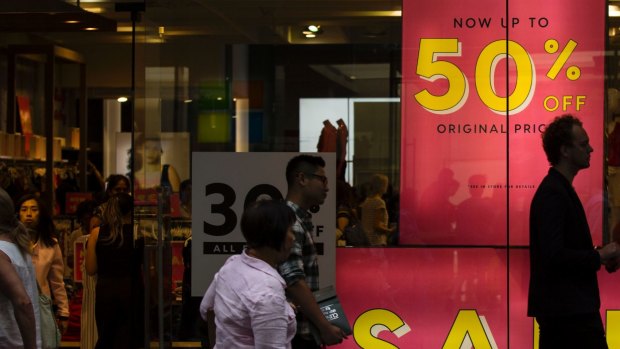By Shane Wright
Australians are buying everyday goods at the slowest rate since the 1990-91 recession as signs grow that interest rate reductions and the Morrison government's tax cuts have failed to encourage shoppers to open their wallets.
As a key measure of the employment market pointed to a slowdown in job creation, Australian Bureau of Statistics retail sales data showed a lower-than-expected 0.2 per cent lift in the value of sales through September.

Retail sale volumes have fallen to their worst annual performance since the 1990-91 recession.Credit: Dominic Lorrimer
Analysts, the government and the Reserve Bank of Australia have been expecting a strong response to recent interest rate cuts, worth about $3 billion a month in extra household disposable income, and the rollout of $7.2 billion of tax cuts directed at low- and middle-income earners.
Instead, retail sales have flatlined, with the volume of sales falling 0.1 per cent in the September quarter. Volumes have now dropped 0.2 per cent over the past 12 months, the worst annual result since Australia's last recession.
In the nation's biggest retail market of NSW, sales are now growing at a slower rate than the overall population.
Sales through the state's specialised food retailers such as bakers and butchers have dropped more than 7 per cent over the past year. Cafes and restaurants have also faced a downturn in trade while consumers have sliced liquor purchases.
There are some signs that shoppers are responding in areas connected to the housing sector following the recent increase in property prices. Sales of household goods improved 0.9 per cent in the quarter, the second consecutive quarterly improvement.
Across Victoria, the value of clothing and footwear sales have grown 5.6 per cent over the past year.
The RBA, which is expected to hold official interest rates at 0.75 per cent at its meeting on Tuesday, is maintaining the economy has reached a "gentle turning point".
But NAB economist Kaixin Owyong said it appeared the nation's consumers were struggling in the opposite direction.
"These data are a worrying sign that overall consumer spending growth was weak in the third quarter despite support from the $7.2 billion of income tax refunds that started flowing from July and the RBA rate cuts in June and July," she said.
When the tax cuts were announced in the April budget, Treasurer Josh Frydenberg said they would lift household incomes and boost spending at local businesses.
But Kmart Group managing director Ian Bailey said ultimately the tax cuts would be difficult to pick up across the retail sector, as they were "not that much money". "If you look at the tax cuts and the other interest rate cuts that have come through, it's hard to identify, but my guess is it's in the system," he said.
The Sydney Morning Herald and The Age revealed at the weekend the average tax refund so far this financial year is a lower-than-expected $420 above the same period last year. There's been a large increase in the number of people doing their own tax returns.
While increased spending may still emerge, 'holiday season' spending now becomes critical.
Ernst & Young chief economist Jo Masters
Ernst & Young chief economist Jo Masters said the caution evident among shoppers meant there was more pressure on retailers to do well during the key Christmas spending period.
"It appears that households are spending less of the stimulus than we would typically expect. The RBA's forecast assumes about half is spent, but this looks optimistic. While increased spending may still emerge, 'holiday season' spending now becomes critical," she said.
The RBA has said one of the main reasons for its decision to cut interest rates was to drive down the unemployment rate, which sits at 5.2 per cent. But ANZ's measure of job advertisements, released on Monday, points to a slowdown in employment intentions.
Job ads slipped a full percentage point in October and are now 11.4 per cent lower than a year ago and at their lowest point since January 2017.
Asia-Pacific chief economist for job site Indeed, Callam Pickering, said low wage growth remained the biggest headwind for the retail sector.
"Right now the retail sector is being kept afloat by high population growth, but that by itself has never been enough to create a strong and vibrant household sector. What retail really needs is higher wage growth," he said.